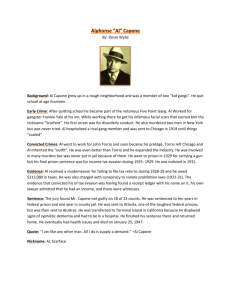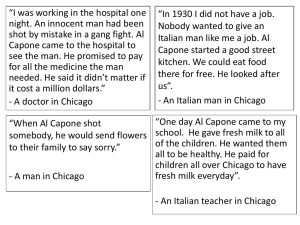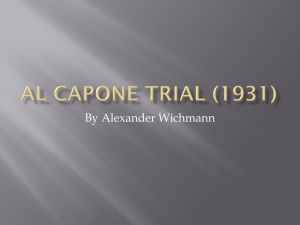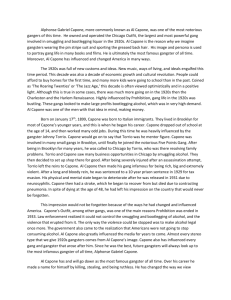Al Capone - Eastern State Penitentiary
advertisement
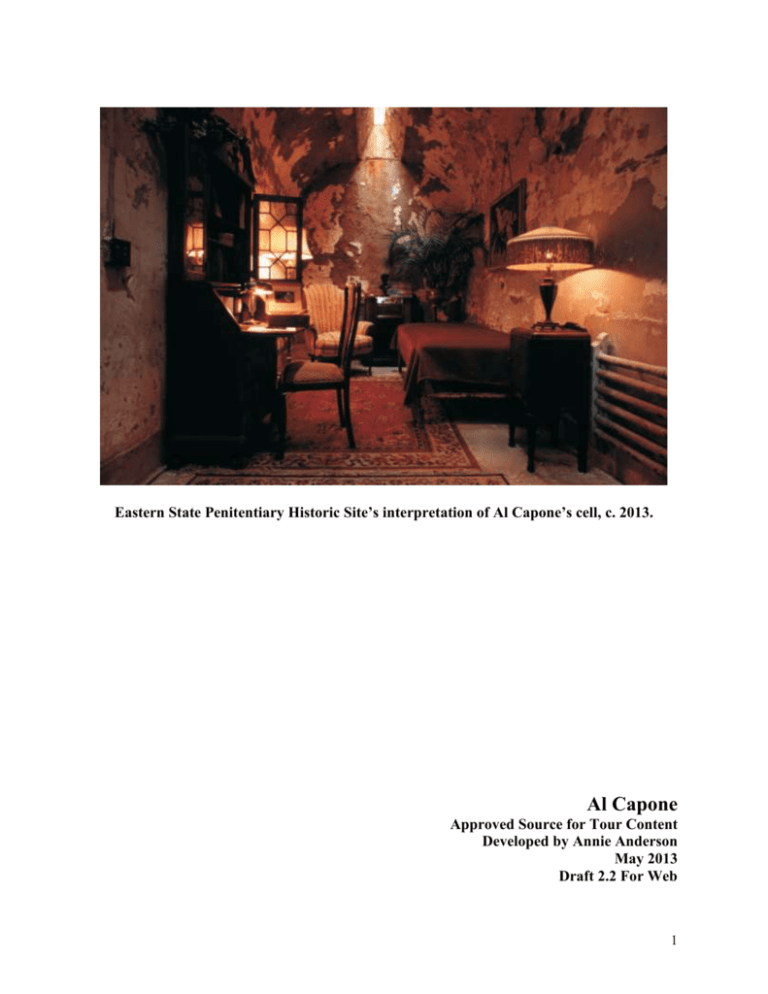
Eastern State Penitentiary Historic Site’s interpretation of Al Capone’s cell, c. 2013. Al Capone Approved Source for Tour Content Developed by Annie Anderson May 2013 Draft 2.2 For Web 1 Guiding questions: How did Al Capone end up at Eastern State Penitentiary? What was his time at ESP like? Did Capone receive special privileges at ESP? How did he get such a lavish cell? In what other prisons was Capone incarcerated? Top talking points: Al Capone had been arrested but never convicted of a crime or sentenced to prison before his 1929 Philadelphia arrest. Capone had never even been photographed or fingerprinted by authorities prior to this. Capone had previously been arrested for carrying a concealed deadly weapon in Joliet, IL; for suspicion of murder in New York City; for disorderly conduct in Olean, NY; for suspicion of murder in Chicago; for violating the National Prohibition Act in Chicago; and many other charges.1 Capone and Cline were arrested on May 16, 1929. Each was charged with carrying a concealed deadly weapon, found guilty, and sentenced to 1 year in prison. Al Capone and his bodyguard Frank Cline had attended a summit of gang leaders in Atlantic City, NJ, and were on their way back to Chicago when they were arrested in Philadelphia on May 16, 1929, outside of the Stanley movie theatre in downtown Philadelphia, at 19th and Market Streets.2 Capone and Cline’s arrest and sentencing took less than 24 hours.3 They were arrested by Detectives James “Shooey” Malone and Jack Creedon around 8:15 p.m. outside the Stanley movie theatre. Malone and Creedon had spotted them entering the theater about an hour earlier.4 Around 9:00 p.m. they were photographed and finger-printed at City Hall. At 11:35 p.m., they were arraigned before Magistrate Edward Carney at the 20th and Buttonwood Streets police station. They were charged with carrying concealed deadly weapons and being suspicious character, and held on $35,000 bail each.5 Magistrate Carney said the “Capone Says He Made Peace With Rivals At Shore: ‘Scarface Al’s’ Time-Table From Seashore to Prison,” The Evening Bulletin, May 17, 1929; Al Capone’s Eastern State Penitentiary Bertillon Card; Al Capone’s United States Penitentiary criminal record, via: http://www.alcatrazhistory.com/cap1.htm. 2 “Capone Says He Made Peace With Rivals At Shore: ‘Scarface Al’s’ Time-Table From Seashore to Prison,” The Evening Bulletin, May 17, 1929 3 Ibid. 4 Ibid. 5 Ibid. 1 2 following about Capone: “Undoubtedly he is responsible for a great number of murders. Authorities in some cities, including District Attorneys, are afraid of him.” He directed his next words at Capone: “But Philadelphia is not afraid of you, Mr. Al Capone! And I am not afraid of you!”6 Capone and Cline were placed in City Hall jail cells for half an hour, and at midnight they were taken before Director of Public Safety Lemuel Schofield, Inspector of Detectives William Connelly, Superintendent of Police William B. Mills, and Assistant Director of Public Safety Theodore F. Wood for questioning. The interview took place between midnight and 2:00 a.m. Capone and Cline slept in City Hall jail cells, and were taken before detectives again at 9:30 a.m. They were placed on trial at 11:30 a.m., and at 12:15 p.m., they plead guilty and were sentenced to one year in prison.7 Capone and Cline spent at least one night in several penal institutions in the Philadelphia area. When they were arrested in Philadelphia, both Capone and Cline spent one night each in a City Hall jail cell and Moyamensing Prison (a county facility).8 They were then sent to Holmesburg Prison (a county facility) for several months, then transferred to Eastern State Penitentiary for several months, where they served the rest of their sentences. The day before they were released, they were transferred to Graterford (then a branch of Eastern State Penitentiary), and were discharged from there.9 o Capone and Cline spent the first several months of their Philadelphia prison sentences at Holmesburg Prison. Capone was at Holmesburg from May 18, 1929 to August 8, 1929, the day he was transferred to ESP.10 Cline was at Holmesburg from May 18, 1929 to September 12, 1929, the day he was transferred to ESP.11 Capone was at ESP for about 7 months, while Cline was at ESP for about 6 months. The official reason given for Capone’s transfer was overcrowding at Holmesburg, though speculation said Capone had been threatened at Holmesburg, and that he would be safer at ESP. The New York Times observed: “From unofficial sources it “‘Scarface Al’ And Pal Held in Cell Here,” The Philadelphia Record, May 17, 1929. “Capone Says He Made Peace With Rivals At Shore: ‘Scarface Al’s’ Time-Table From Seashore to Prison,” The Evening Bulletin, May 17, 1929. 8 “Capone Says He Made Peace With Rivals At Shore: ‘Scarface Al’s’ Time-Table From Seashore to Prison,” The Evening Bulletin, May 17, 1929; “Capone Jailed Here For Year, ‘Feels Secure,’” Public Ledger, May 18, 1929. 9 “Al Capone Moved to Eastern ‘Pen’,” unknown newspaper, August 9, 1929; Warden’s Daily Journal, March 17, 1930. 10 “Al Capone Moved to Eastern ‘Pen’,” unknown newspaper, August 9, 1929. 11 Frank Cline commitment papers, ESP Archives. 6 7 3 was reported that the sudden transfer was made after threats and murmurings at [Holmesburg] had taken on an alarming tone.”12 A letter from ESP Parole Officer Courtland Butler reveals that a special arrangement had been made to bring Capone to ESP. Butler wrote: “On August 8th, 1929 we received from the Phialdelphia County Prison by Order of Judge McDevitt, Al Capone, Scarface Al, on a transfer.” ESP “transferred to the Philadelphia County Prison (Holmesburg), in a sort of exchange, C5120, Joseph Wehgartner, who was sentenced February 4, 1929 in Philadelphia County to serve 8 ½ to 17 years in the Philadelphia County Prison, who was later transferred to the Eastern State Penitentiary.”13 This prisoner exchange was requested by Dr. Goddard, the vice president of the prison’s board of trustees and the ESP physician who would later remove Capone’s tonsils in the ESP hospital.14 Upon arrival at ESP, Capone was placed on the Cellblock 4 gallery—an isolation section of ESP—for two weeks before being transferred to a different cell. When Capone arrived at ESP, his civilian clothes were taken from him and he was given an ESP blue denim uniform. He was bathed and shaved, given an inmate number, and photographed and fingerprinted. He was also vaccinated and his blood was tested.15 The boxer Mickey Walker was one of Capone’s first visitors at ESP once Capone emerged from “isolation” on the Cellblock 4 gallery, around August 19, 1929.16 Capone had two medical procedures while at ESP. Capone had a minor surgery around August 20, 1929; a reporter for The Philadelphia Record noted that Capone was reading a Napoleon Bonaparte biography as he recovered in the prison hospital.17 It’s unclear what this surgical operation was. However, there is a rumor that Capone was circumcised while at Eastern State. A relative of ESP Resident Physician Dr. George Heckman has stated to Historic Site staff that Dr. Heckman “Capone Is Shifted to Another Prison Because Fellow-Inmates Threatened Him,” New York Times, August 9, 1929. 13 Letter to B. L. Scott from Courtland Butler, August 12, 1929, Philadelphia City Archives. B. L. Scott was the director of the Bureau of Restoration, a division of the Department of Welfare that dealt with prison affairs. 14 Letter to B. L. Scott from Courtland Butler, August 12, 1929, Philadelphia City Archives. 15 “Al Capone Moved to Eastern ‘Pen’,” unknown newspaper, August 9, 1929; “Al Capone Likes His New Quarters,” Evening Bulletin, August 9, 1929. 16 “Mickey Walker Visits Al Capone In Prison Cell,” Philadelphia Inquirer, August 20, 1929. 17 “Capone ‘Goes Tunney’ With Acrid Criticism On Own ‘Biographer’,” The Philadelphia Record, August 21, 1929. 12 4 performed this procedure on Capone during his time at ESP.18 Dr. Heckman was ESP’s resident physician for several years in the late 1920s.19 In the late 1800s through the 1920s, circumcision was being evaluated by the medical community as a possible treatment and/or prevention of sexually transmitted diseases.20 Capone suffered from syphilis and gonorrhea during his life.21 It’s possible this was the mystery operation he had at ESP, especially considering the quality of the prison’s medical care and Capone’s medical issues, but the sources are extremely limited. Capone had his tonsils taken out on September 5, 1929, by Dr. Herbert Goddard, a physician at ESP and the vice president of the prison’s board of trustees.22 Capone had a cellmate for at least part of his imprisonment at ESP. An Evening Bulletin article noted that Capone shared a cell with a convicted embezzler known as “Bill” Coleman, a prison statistician. Capone and Coleman’s cell contained a small table with a vase of gladioli; a Victrola record player, a French dresser, a few pictures on the wall, a smoking stand, and a prison-made rag rug.23 An article published shortly before Capone’s release from ESP claimed he had a cellmate who was a forger.24 Capone was a very well known and oft-publicized prisoner, but ESP administrators denied Capone received special treatment, maintaining that his experience as an inmate was similar to other inmates’. Though the prison system treated Capone to exceptional privileges—transferring him by special arrangement from Holmesburg to ESP, housing him in the “Park Avenue” section of cells—ESP administrators maintained that he wasn’t favored over other inmates. Shortly after Capone arrived at ESP, Warden Herbert Smith denied that Capone received special treatment. He said: “This man, called a gangster, comes here to me as just another Email correspondence between Dr. Heckman’s relative and Ang Reidell, 2007. Dr. George Heckman is listed as ESP’s resident physician in the prison’s annual reports for year ending May 31, 1927; for year ending May 31, 1928; and for year ending May 31, 1929. It is unknown when Heckman left ESP, though in the annual report for year ending May 31, 1930, Chalmers Cornelius is listed as the prison’s resident physician. 20 “Circumcision and Syphilis,” British Medical Journal, January 27, 1934; “Circumcision in Treatment of Chancroidal Lesions of Male Genitalia,” JAMA Dermatology, February 1939. 21 Clinical Record, Al Capone Terminal Island Medical Files, National Archives and Records Administration, San Francisco. 22 “Capone’s Tonsils Removed In Prison,” Evening Bulletin, September 7, 1929. 23 “Capone ‘Goes Tunney’ With Acrid Criticism On Own ‘Biographer’,” The Philadelphia Record, August 21, 1929. 24 “Al Capone, Near Freedom, Is Expected To Resume His Role of Racket Chief,” Ottawa Citizen, March 8, 1930. 18 19 5 prisoner. I’m not interested in his past—I’m more interested in his behavior here.” Smith went on to say: “all this bunk about Capone being a pet is wrong.”25 Toward the end of Capone’s incarceration, Smith maintained that Capone never received preferential treatment: “My ideas of penology are based on common sense. I’m not interested in a man’s past so much as his conduct here. Nobody is shown any favoritism, millionaire or pauper. Capone worked hard and observed every rule, and earned his two months off for good behavior.”26 Capone was processed as any other prisoner would’ve been upon entering ESP; he was “accorded no more privileges or recognition than any other prisoner” when he arrived at ESP on August 8, 1929.27 Shortly after Capone arrived at ESP, the Philadelphia Public Ledger observed that Capone’s “formerly cheerless” cell floor was now “covered by a beautiful rug,” and that “tasteful paintings” hung on the walls. The newspaper reported that “[e]verything was cheery and homelike” in Capone’s cell, which included a cabinet radio, a polished desk, a chest of drawers, and a bed. Although the Public Ledger insinuated Capone enjoyed a special status in a “luxurious” cell, it did not report on any other cells at ESP, and it’s unclear from this article how Capone’s cell differed from his fellow inmates’ cells.28 A newspaper article written about 10 days before his release noted that Capone and his cellmate, a forger, “had no better quarters than scores of other men. Prison-made rag rugs gaily colored, covered the cold concrete floor and there were a few pictures on the walls. A small table and two comfortable cots comprised the furniture. A cheap radio and a phonograph had been purchased from the prisoners who previously had occupied the cell.”29 Capone seems to have had access to the same furnishings that other ESP inmates had access to. The article notes: “regular cells may be decorated and furnished by the prisoners with the few luxuries obtainable at the prison store.”30 In this same article, Dr. Goddard claimed that Capone “lost some surplus weight and a couple of defective tonsils” while at ESP. Goddard also said that Capone played handball and baseball while at ESP, and that he worked hard at the office jobs assigned him. “He has read a lot of good books, too,” Goddard added. While at ESP, Capone wrote “scores of letters” and received many in return.31 25 Ibid. “Al Capone, Near Freedom, Is Expected To Resume His Role of Racket Chief,” Ottawa Citizen, March 8, 1930. 27 “Al Capone Likes His New Quarters,” Evening Bulletin, August 9, 1929. 28 “‘Very Comfortable,’ Says Capone, In Luxurious Cell at Eastern ‘Pen’,” Public Ledger, August 20, 1929. 29 “Al Capone, Near Freedom, Is Expected To Resume His Role of Racket Chief,” Ottawa Citizen, March 8, 1930. 30 Ibid. 31 Ibid. 26 6 Though the extent of Capone’s charity is unknown, there is evidence that he used his wealth to aid fellow inmates. An unnamed prison official claimed that Capone donated “25 heaping baskets of food” to fellow inmates’ needy families around Christmas in 1929. This same official also noted that Capone donated $1,500 to a new children’s hospital, and that he purchased 200 tickets to a charity benefit organized by the University of Pennsylvania, even though he himself couldn’t attend because he was in prison. “Through the prison chaplain he has sent money to aid poor families outside. One woman with eight children who was about to be evicted from her home received $200. He paid another’s hospital bills and offered her husband a job! This was declined with thanks, nobody knowing just what the ‘job’ would be,” the anonymous official told a reporter.32 Though some newspaper accounts and historians suggest that Capone intentionally had himself arrested in Philadelphia to avoid potential revenge in Chicago for the St. Valentine’s Day massacre, there is no evidence that this is true. Capone made six attempts, via legal action, to free himself from ESP.33 Capone always maintained that he did not purposely get arrested in Philadelphia: “One thing I would like to set at rest is the report that I went into jail to dodge something,” he commented a month after his release from ESP. “If I wanted to go to jail, I certainly wouldn’t pick one in Pennsylvania. I would have looked around for one where there were more conveniences.”34 Capone and Cline were transferred to Graterford on March 16, 1929, and were released from there on March 17, 1929. Capone and Cline’s release from Graterford was planned and implemented by Warden Herbert Smith and the ESP Board of Trustees to avoid any potential violence outside of the Philadelphia prison.35 Capone and Cline each served a total of 10 months in prison in Philadelphia, having received two months off their sentences for good behavior.36 Capone’s arrest in Philadelphia marked the start of a near decade of constant imprisonment for him. 32 Ibid. “Capone Seeks to Leave Jail,” Painesville Telegraph, October 19, 1929; “Al Capone, Near Freedom, Is Expected To Resume His Role of Racket Chief,” Ottawa Citizen, March 8, 1930. 34 “Three Al Capone Henchmen Slain in Chicago Saloon,” The Telegraph-Herald and Times-Journal, April 21, 1930. 35 Warden’s Daily Journal, March 16, 1930; “Capone Slips Away From New Prison, Eluding Throngs,” New York Times, March 18, 1930. 36 “Will Usher Capone Out of Quaker City,” New York Times, March 16, 1930. 33 7 After Capone was released from ESP, he was out of prison for about a year-and-a-half. He was convicted of tax evasion in a federal court in Chicago in October 1931. He was incarcerated from late 1931 until late 1939 in various federal prisons, including the United States Penitentiaries in Atlanta, San Francisco (Alcatraz), and Los Angeles (Terminal Island). After his release from federal prison in 1939, he was never incarcerated again. He died in 1947 at his home in Miami.37 Though Capone “achieved the reputation of being a model prisoner” while incarcerated at Alcatraz, he was involved in altercations with other inmates. He was stabbed by fellow inmate James C. Lucas in June 1936. Lucas, a Texas bank robber, knifed Capone in the back with a scissors blade. Capone’s injury was not serious, though he did seek treatment in the prison hospital.38 Rumors circulated that Capone received threats from other inmates, and his transfer to Terminal Island in 1939 was called a “‘promotion’…after his not-too-happy years at grim Alcatraz.”39 Capone had chronic medical problems. Capone’s medical assessment upon arriving at the federal prison at Terminal Island on January 7, 1939, noted that he had syphilis and gonorrhea, and that he had suffered from general paresis, a side effect of syphilis that entails progressive dementia and partial paralysis, since February 1938. The doctor writing the assessment observed that “he is slightly confused and somewhat unstable…and his speech is somewhat slurring in character.”40 When Capone was released from Terminal Island in November 1939, he spent several months undergoing treatment for paresis in a Baltimore hospital.41 He arrived at his home in Miami in March 1940. He rarely left Miami until his death from a stroke and pneumonia in 1947.42 There is no evidence to support these common claims about Al Capone’s time in Philadelphia: That Capone was purposely arrested in Philadelphia to avoid repercussions from the St. Valentine’s Day massacre in Chicago. That Capone bought baseball or band uniforms for ESP inmates. That his cell door was left unlocked. That he received special privileges, like access to the warden’s phone. 37 This information is culled from newspaper articles footnoted throughout this source. “Capone Stabbed at Alcatraz; Fells Fellow-Convict With Fist,” Gettysburg Times, June 24, 1936. 39 “Capone Taken from Alcatraz to New Prison,” St. Petersburg Times, January 8, 1939. 40 Clinical Record, Al Capone Terminal Island Medical Files, National Archives and Records Administration, San Francisco. 38 41 “Capone Confined To Room In Hospital,” The Portsmouth Times, November 17, 1939; “Al Capone Arrives At Florida Estate,” The Milwaukee Sentinel, March 21, 1940. 42 “Famous Cases & Criminals,” The Federal Bureau of Investigation: http://www.fbi.gov/about-us/history/famouscases/al-capone; “Al Capone Dead,” The Sydney Morning Herald, January 27, 1947. 8 Where exactly Capone’s cell was; some oral histories claim that Capone was housed on Cellblock 9, in the cell that became the barbershop, but we have no primary sources regarding his cell location.43 Where the “Park Avenue” section of cells was located, where Capone was housed.44 The oral tradition among former ESP employees asserts that “Park Avenue” consisted of the four cells outside the headgates where Cellblocks 8 and 9 meet. Where Frank Cline’s cell was. That Capone and Cline’s cells were never used to house inmates again. What kind of “minor surgical operation” Capone underwent in August 1929, shortly after his arrival at ESP and before his tonsils were removed in September 1929.45 Appendix: Timelines Significant Events Preceding Capone’s Philadelphia Incarceration February 14, 1929: The “St. Valentine’s Day Massacre” occurs in Chicago, in which seven mob associates of George “Bugs” Moran, an Al Capone rival, are executed.46 February 27, 1929: Capone is subpoenaed in Miami to appear as a witness before a federal grand jury in Chicago for a case involving Prohibition violations. Capone says that he is too sick to travel to Chicago.47 March 27, 1929: Federal agents in Florida investigate Capone’s excuse and find that he is going to the racetrack and taking trips to the Bahamas. Capone is cited for contempt of court in Chicago and arrested in Miami. He is released on bond.48 c. May 10-16, 1929: Capone, Cline, and other gangsters, including Capone’s Chicago rival Bugs Moran, convene at the President Hotel in Atlantic City to develop a “peace pact” among their rival factions. They sign a peace treaty after six days of negotiations.49 Capone’s Philadelphia Arrest and Incarceration May 16, 1929: Al Capone and Frank Cline are arrested in Philadelphia by Detectives John Creedon and James Malone outside of the Stanley movie theater at 19th and Market Streets. They are questioned at City Hall and spend the night in a cell there.50 May 17, 1929: Al Capone and Frank Cline both plead guilty and are sentenced to one year in prison. They spend the night in Moyamensing Prison, a county facility. 51 43 Eastern State Penitentiary Historic Structures Report, pages 182 and 205. “Capone’s Tonsils Removed In Prison,” Evening Bulletin, September 7, 1929. 45 “Capone’s Tonsils Removed,” New York Times, September 8, 1929. 46 “Capone Given Jail Term at Philadelphia,” Schenectady Gazette, May 18, 1929. 47 “Solving Scarface: How the Law Finally Caught Up With Al Capone,” The Federal Bureau of Investigation: http://www.fbi.gov/news/stories/2005/march/capone_032805. 48 Ibid. 49 “Will Usher Capone Out of Quaker City,” New York Times, March 16, 1930; “Al Capone Sentenced To Jail For Year,” The Border Cities Star, May 17, 1929. 50 “‘Scarface Al’s’ Time-Table From Seashore to Prison,” The Evening Bulletin, May 17, 1929. 44 9 May 18, 1929: Capone and Cline are transferred to Holmesburg Prison, a county facility.52 August 8, 1929: Capone is transferred to Eastern State Penitentiary.53 Capone spends his first several days at ESP in quarantine. A news article notes that Capone will be given some work to do, whereas at Holmesburg he “idled his time away in his cell.”54 September 5, 1929: Capone has his tonsils removed in the ESP hospital by Dr. Herbert Goddard, an ESP physician and vice president of the prison’s board of trustees.55 September 12, 1929: Cline is transferred to ESP.56 October 18, 1929: Attorneys for Capone and Cline file habeas corpus petitions—legal actions that require an inmate be brought before a judge or into court—for their discharge. This is the fifth attempt by legal action to free Capone and Cline.57 March 16, 1930: Al Capone and Frank Cline are transferred to Graterford by order of the Eastern State Board of Trustees.58 March 17, 1930: Al Capone and Frank Cline’s sentences are commuted and they are released from Graterford.59 They are released two months early on account of good behavior. Hundreds of curiosity seekers and reporters gather outside ESP to catch a glimpse of Capone.60 Capone’s Post-ESP Life and Imprisonment March 18, 1930: Capone and Cline leave the Philadelphia area, arriving in Chicago the next day.61 March 21, 1930: Capone pays a visit to Chicago Chief of Detectives John Stege, as well as the United States’ District Attorney’s and the State’s Attorney’s offices in Chicago. He wore glasses, claiming that the poor light in his prison cell in Philadelphia ruined his eyes.62 October 17, 1931: Capone is convicted of tax evasion. Jurors find Capone guilty of evasion of taxes during 1925, 1926, and 1927; and failure to file tax returns in 1928 and 1929.63 October 24, 1931: Capone is sentenced to 11 years in federal prison, fined $50,000, and charged $7,692 for court costs, in addition to $215,000 plus interest on back taxes. During appeals to his sentence, he is confined at Cook County Jail in Chicago.64 May 3, 1932: Federal agents escort Capone from Cook County Jail to the federal penitentiary in Atlanta, Georgia, via train. Capone was originally sentenced to Leavenworth Federal Penitentiary in Kansas, but officials decided at the last minute to send him to Atlanta.65 “Capone Jailed Here For Year, ‘Feels Secure,’” Public Ledger, May 18, 1929. “Aides Organize For Legal Fight To Free Capone,” Public Ledger, May 19, 1929. 53 “Capone Moved Into Eastern Penitentiary,” The Washington Reporter, August 9, 1929. 54 “Move Al Capone for Safety Sake,” The Telegraph-Herald and Times-Journal, August 9, 1929. 55 “Capone’s Tonsils Removed,” New York Times, September 8, 1929. 56 Frank Cline commitment papers, ESP Archives. 57 “Capone Seeks to Leave Jail,” Painesville Telegraph, October 19, 1929. 58 Warden’s Daily Journal, March 16, 1930. 59 Warden’s Daily Journal, March 17, 1930. 60 “Slips Away Unseen,” Reading Eagle, March 16, 1930. 61 “Al Capone Gives Self Up To Chicago Police Head,” The Evening Independent, March 21, 1930. 62 Ibid. 63 “Capone To Ask For New Trial,” The Evening Independent, October 19, 1931. 64 “Famous Cases & Criminals,” The Federal Bureau of Investigation: http://www.fbi.gov/about-us/history/famouscases/al-capone. 51 52 10 May 4, 1932: Capone enters the federal penitentiary in Atlanta, Georgia.66 August 20, 1934: Capone is transferred to Alcatraz Federal Prison in San Francisco, CA.67 June 23, 1936: Capone is stabbed with scissors by a fellow prisoner at Alcatraz.68 January 7, 1939: Capone is transferred from Alcatraz to the federal prison on Terminal Island in the Los Angeles harbor.69 November 12, 1939: Capone is transferred to Lewisburg Federal Prison in Pennsylvania.70 November 16, 1939: Capone is released from Lewisburg Federal Prison to his relatives.71 November 17, 1939: Capone enters Baltimore General Hospital for treatment of paresis, a side effect of syphilis that entails progressive dementia and partial paralysis. He is treated by Dr. Joseph Moore, former director of the syphilis division of the Johns Hopkins medical clinic.72 March 20, 1940: Capone arrives at his home in Miami after his extended hospital stay in Baltimore.73 He lives in relative seclusion here, rarely returning to Chicago.74 June 28, 1946: Dr. Kenneth Phillips, Capone’s physician, declares that Capone is “nervous and excitable,” with little knowledge of the outside world. Capone is described as having the mentality of a child.75 January 25, 1947: Capone dies from a stroke and pneumonia at his home on Palm Island in Miami.76 “Al Capone Is Sent to Federal Penitentiary at Atlanta, Georgia,” The Mount Airy News, May 5, 1932. “Atlanta Prison Cell Claiming Al Capone,” Times Daily, May 5, 1932 67 “Capone Sent To Alcatraz,” San Jose News, August 20, 1934. 68 “Capone Stabbed at Alcatraz; Fells Fellow-Convict With Fist,” Gettysburg Times, June 24, 1936. 69 “Capone Taken from Alcatraz to New Prison,” St. Petersburg Times, January 8, 1939. 70 In-Patient Medical Record, Al Capone Terminal Island Medical Files, National Archives and Records Administration, San Francisco. 71 Ibid. 72 “Capone Confined To Room In Hospital,” The Portsmouth Times, November 17, 1939. 73 “Al Capone Arrives At Florida Estate,” The Milwaukee Sentinel, March 21, 1940. 74 “Famous Cases & Criminals,” The Federal Bureau of Investigation: http://www.fbi.gov/about-us/history/famouscases/al-capone. 75 “Al Capone’s Mind Is That of Child,” Spokane Daily Chronicle, June 28, 1946. 76 “Al Capone Dead,” The Sydney Morning Herald, January 27, 1947. 65 66 11
